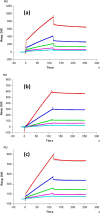High structural resolution hydroxyl radical protein footprinting reveals an extended Robo1-heparin binding interface
- PMID: 25752613
- PMCID: PMC4409239
- DOI: 10.1074/jbc.M115.648410
High structural resolution hydroxyl radical protein footprinting reveals an extended Robo1-heparin binding interface
Abstract
Interaction of transmembrane receptors of the Robo family and the secreted protein Slit provides important signals in the development of the central nervous system and regulation of axonal midline crossing. Heparan sulfate, a sulfated linear polysaccharide modified in a complex variety of ways, serves as an essential co-receptor in Slit-Robo signaling. Previous studies have shown that closely related heparin octasaccharides bind to Drosophila Robo directly, and surface plasmon resonance analysis revealed that Robo1 binds more tightly to full-length unfractionated heparin. For the first time, we utilized electron transfer dissociation-based high spatial resolution hydroxyl radical protein footprinting to identify two separate binding sites for heparin interaction with Robo1: one binding site at the previously identified site for heparin dp8 and a second binding site at the N terminus of Robo1 that is disordered in the x-ray crystal structure. Mutagenesis of the identified N-terminal binding site exhibited a decrease in binding affinity as measured by surface plasmon resonance and heparin affinity chromatography. Footprinting also indicated that heparin binding induces a minor change in the conformation and/or dynamics of the Ig2 domain, but no major conformational changes were detected. These results indicate a second low affinity binding site in the Robo-Slit complex as well as suggesting the role of the Ig2 domain of Robo1 in heparin-mediated signal transduction. This study also marks the first use of electron transfer dissociation-based high spatial resolution hydroxyl radical protein footprinting, which shows great utility for the characterization of protein-carbohydrate complexes.
Keywords: Glycosaminoglycan; Heparin; Heparin-binding Protein; Hydroxyl Radical Protein Footprinting; Mass Spectrometry (MS); Protein-Carbohydrate Interaction; Structural Biology.
© 2015 by The American Society for Biochemistry and Molecular Biology, Inc.
Figures










Similar articles
-
Structural and functional analysis of slit and heparin binding to immunoglobulin-like domains 1 and 2 of Drosophila Robo.J Biol Chem. 2008 Jun 6;283(23):16226-34. doi: 10.1074/jbc.M800688200. Epub 2008 Mar 20. J Biol Chem. 2008. PMID: 18359766 Free PMC article.
-
Structural insights into the Slit-Robo complex.Proc Natl Acad Sci U S A. 2007 Sep 18;104(38):14923-8. doi: 10.1073/pnas.0705310104. Epub 2007 Sep 11. Proc Natl Acad Sci U S A. 2007. PMID: 17848514 Free PMC article.
-
Slit Binding via the Ig1 Domain Is Essential for Midline Repulsion by Drosophila Robo1 but Dispensable for Receptor Expression, Localization, and Regulation in Vivo.G3 (Bethesda). 2015 Sep 10;5(11):2429-39. doi: 10.1534/g3.115.022327. G3 (Bethesda). 2015. PMID: 26362767 Free PMC article.
-
Structural insight into Slit-Robo signalling.Biochem Soc Trans. 2008 Apr;36(Pt 2):251-6. doi: 10.1042/BST0360251. Biochem Soc Trans. 2008. PMID: 18363568 Review.
-
Structure and Function of Roundabout Receptors.Subcell Biochem. 2019;93:291-319. doi: 10.1007/978-3-030-28151-9_9. Subcell Biochem. 2019. PMID: 31939155 Review.
Cited by
-
NMR analysis suggests the terminal domains of Robo1 remain extended but are rigidified in the presence of heparan sulfate.Sci Rep. 2022 Aug 30;12(1):14769. doi: 10.1038/s41598-022-18769-6. Sci Rep. 2022. PMID: 36042257 Free PMC article.
-
Chemical Penetration Enhancers Increase Hydrogen Peroxide Uptake in C. elegans for In Vivo Fast Photochemical Oxidation of Proteins.J Proteome Res. 2020 Sep 4;19(9):3708-3715. doi: 10.1021/acs.jproteome.0c00245. Epub 2020 Jun 17. J Proteome Res. 2020. PMID: 32506919 Free PMC article.
-
Orthogonal Mass Spectrometry-Based Footprinting for Epitope Mapping and Structural Characterization: The IL-6 Receptor upon Binding of Protein Therapeutics.Anal Chem. 2017 Jul 18;89(14):7742-7749. doi: 10.1021/acs.analchem.7b01748. Epub 2017 Jul 6. Anal Chem. 2017. PMID: 28621526 Free PMC article.
-
Hydrogen-Deuterium Exchange and Hydroxyl Radical Footprinting for Mapping Hydrophobic Interactions of Human Bromodomain with a Small Molecule Inhibitor.J Am Soc Mass Spectrom. 2019 Dec;30(12):2795-2804. doi: 10.1007/s13361-019-02316-1. Epub 2019 Nov 12. J Am Soc Mass Spectrom. 2019. PMID: 31720974 Free PMC article.
-
Assessing Genetic Algorithm-Based Docking Protocols for Prediction of Heparin Oligosaccharide Binding Geometries onto Proteins.Biomolecules. 2023 Nov 9;13(11):1633. doi: 10.3390/biom13111633. Biomolecules. 2023. PMID: 38002315 Free PMC article.
References
-
- Garbe D. S., Bashaw G. J. (2004) Axon guidance at the midline: from mutants to mechanisms. Crit. Rev. Biochem. Mol. Biol. 39, 319–341 - PubMed
-
- Dickson B. J., Gilestro G. F. (2006) Regulation of commissural axon pathfinding by slit and its robo receptors. Annu. Rev. Cell Dev. Biol. 22, 651–675 - PubMed
-
- Kidd T., Brose K., Mitchell K. J., Fetter R. D., Tessier-Lavigne M., Goodman C. S., Tear G. (1998) Roundabout controls axon crossing of the CNS midline and defines a novel subfamily of evolutionarily conserved guidance receptors. Cell 92, 205–215 - PubMed
-
- Huminiecki L., Gorn M., Suchting S., Poulsom R., Bicknell R. (2002) Magic roundabout is a new member of the roundabout receptor family that is endothelial specific and expressed at sites of active angiogenesis. Genomics 79, 547–552 - PubMed
Publication types
MeSH terms
Substances
Grants and funding
LinkOut - more resources
Full Text Sources
Other Literature Sources
Medical

